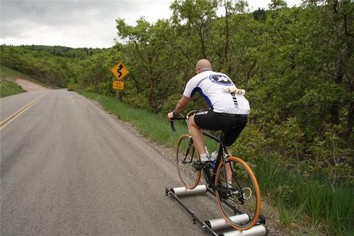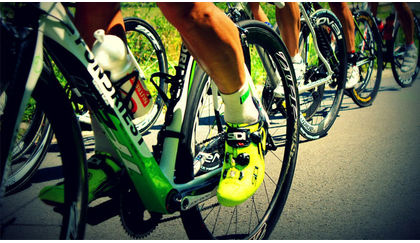
I was talking to a BikeRoar associate yesterday about comparative weather conditions and he told me that his home town could expect up to 55 inches of snow in winter... 55 inches! It took a while to sink in. That's enough to completely cover my nine year old daughter.
The conversation brought back memories of a winter ride with another staff member. On that fateful morning the temperature, in a town not far from where we rode, recorded (as I only later discovered) 24°F (-4°C). It probably wasn't quite that cold on our ride, but by the look of the totally iced up winter wonderland surrounding us, I think it may have been pretty close.
The problem wasn't that it was cold, it was more how ill-equipped we were to deal with it. Didn't someone say, "no such thing as bad weather, just wrong clothes"?! Well, I was wearing a summer jersey and knicks, arm and knee warmers, thin summer gloves, a wind vest, and, thankfully, I had my ear warmers! My companion was similarly dressed.
We suffered terribly. My friend's hands were so frozen he couldn't operate his gears or brakes. My bike was vibrating so badly on every descent that I was worried my wheel was loose in the dropout, or that I had a broken spoke, or had a loose headset... until I realized the vibration was me — shivering uncontrollably.
55 inches of snow. "So how do you ride in winter?" I asked when the shock of these obscene conditions receded. "Three months on a wind trainer," was the response.
Now, I'm not sure, but I think I recovered from the ride around lunch time. I have been on stationary trainers many times — too many times in fact, and I sold my last one for a dozen beers. Perhaps I will get drunk and fat, but at least I won't be bored out of my mind sitting on a trainer, dripping sweat, and counting the bricks on my garage wall — 600 and something at last count.

In saying this, there are moments — a snow bank blocking the front door will do it — when the only course of action is to jump on the trainer and have a sweat session. So, here are some survival tips for winter training indoors.
Buy a fan
You will realize you want this within the first ten minutes of effort. Even when setup outdoors, the lack of wind results in our bodies overheating straight away. A pedestal mounted fan simulates the wind when riding normally. The great thing is you can set it up as a head or cross wind and it matters nought!
Protect your bike
Drape a towel over your top tube or purchase a frame protector to capture all the sweat that will inevitably drip off you. This is very important, as that sweat is full of salt and it will collect and corrode your bike and components very quickly. Most trainer manufacturers also make sweat guards / nets, like: Elite Protec Sweat Net, Blackburn Sweat Net, CycleOps Sweat Guard, and Minoura Safe-T Net 2 Bicycle Trainer Sweat Net.
If you like your floor or carpet, drop a towel under you and your bike to save those, too. You can buy purpose-made mats, like the Trainer Mat Deluxe by Blackburn Design, or the sound dampening Training Mat Pro by BKOOL, or try a cheap yoga mat.
Alleviate boredom
If you can't afford a virtual reality training system, set up your bike and trainer in front of the television and play a cycling DVD to get in the mood. You may need to plug in headphones as certain types of trainers can be very noisy!
RELATED: Zwift and Compatible Indoor Trainers
Choose the right tires
It is very important to use a slick tire on certain types of trainers, particularly if you have a mountain bike. They run more smoothly and eliminate a lot of the noise. If possible I would recommend a spare wheel with a cheap, slick, training tire mounted, so it is easier to swap out.
Also, bear in mind that trainers which use tire contact to activate resistance will wear a flat spot down the centre of the tire. There are specific tires for windtrainers, like the Continental Hometrainer or CycleOps Trainer Tire.
Computers and Power Meters
Invest in a cadence computer, a heart rate monitor, or both. Many computers cover all these functions and are a good idea if you're really into your training. You can also get power metering devices, but if you are at that level you probably don't need advice from me!
RELATED: Find and compare Power Meters →
Monitoring cadence and heart rate is a way to keep track of your fitness and to make indoor training interesting. It's great to have displayed in front of you how hard your body is working, and if you setup specific training zones, it is simple to keep within your own levels.
Training
Recent studies have found that it is more beneficial to use short, intense intervals than a long drawn out tempo at certain times in your training regime. Intensity shocks the system, resulting in the body using more efficient energy systems, and can lead to increased fitness and more calories burnt with less time spent.
My typical indoor training ritual would be a 10-20 minute warm up at an easy, yet increasing resistance, followed by a period of intense sprint intervals and then a 10 minute warm down. The intervals would be, for example: 3 x 30 second sprints with a few minutes rest between. All over, I would rarely spend more than an hour per session all told.
The beauty of creating a structure when indoor training is: firstly, it helps keep the exercise interesting so you will be more willing to keep it up, and secondly: you can keep track of how your body responds to a set ritual of stress and rest. It is interesting in particular to note how quickly you recover from an interval and to watch this variable change over the whole winter.
For a suitable training regime, I recommend speaking to an expert in the field and formulating a plan specifically suited to your needs.
I did start off by stating that indoor trainers are boring, but it isn't completely true. With a structured and purposeful intention, indoor training, especially in the winter, can be a fascinating exercise in watching how our bodies respond to work in a controlled environment, and can lead to great gains in fitness.
It is a pity I sold mine for half a carton of beer...
Editor's Note: This article was originally published Wednesday, Jan 23, 2013 and has been revised for editing and accuracy.

RELATED ARTICLE:
Roll On Rollers
Learning to ride on rollers can be challenging, but it can revolutionize your indoor training and has many flow-on benefits... READ MORE

RELATED ARTICLE:
5 minute drills to make you fast: Pedaling technique
We look at some ways to improve the efficiency of your pedal movement. These drills are easy and quick to do and can be incorporated into your normal riding or spin class... READ MORE




